
Dipnet Critters
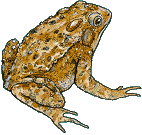
|
American Toad -
Toads are amphibians that lay their eggs in the water. They spend their early lives as tadpoles. Once they grow legs they spend most of their lives on land. Toads have bumpy, brown dry skin. Donít worry, they canít give you warts! (6 - 8 cm) |

|
Arrow Arum seeds -
Arrow arum is a plant that is frequently found in the marsh. It produces thousands of shiny green seeds. Do you see how the plant gets its name? (.5 cm) |

| Backswimmer -
These insects swim belly up. When submerged in water, they carry a bubble of air on their abdomens and under their wings. They use their short front legs to grab prey such as snails or small fish, and then they use a needle-like mouth to suck out the body juices. WARNING: Be careful when handling this insect because it can give you a sharp, painful bite! (.8 - 1.7 cm) |

|
Banded Killifish -
These fish are only about three inches long, so they canít hurt you, but they do eat amphipods. You can recognize them because they have bars on their sides and a "squared", not rounded tail fin. Because their mouths are on the "top" of their faces, they can catch food on the waterís surface. They are prey for many larger fish. (5 - 8 cm) |

|
Blacknose Dace -
The blacknose dace has a black line down its side from the tip of its black nose to the tip of its forked tail. Its mouth is located on the bottom of its face. It lives in fast moving streams. (5 - 8 cm) |
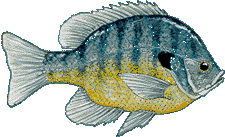
| Bluegill
The bluegill fish has a rounded shape and a dark blue spot on the back edge of the gill cover. (10 - 25 cm) |
|
|
Caddisfly Larvae -
Caddisflies are insects that begin their life in water. They build a "house" by cementing sand, leaves, or small sticks together. They have hooks to anchor their soft delicate bodies inside the protective case, which is secured under a rock in the creek. When they are adults they will fly on transparent wings. (.4 - 1.8 cm) |
|
|
Cranefly Larvae -
Adult craneflies look like giant mosquitoes - but donít worry, they suck plant juices, not blood! When they are young, craneflies have a worm-like body that can expand and contract in length like an accordion. The larva breathes through its rear end! Look for the spiracles that are used for breathing. They resemble tiny tentacles. (1 - 5 cm) |
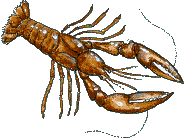
|
Crayfish -
Crayfish are crustaceans related to lobsters. They swim backwards and breathe with gills. They eat anything they can catch with their claws, but they are usually scavengers eating dead plants and animals. (3 - 15 cm) |

|
Dragonfly nymph -
Did you think you would ever see an insect that could catch and eat a small fish or insect? This dragonfly nymph can! The adult dragonfly dips her tail in the water to lay eggs. The nymph hatches from the egg and lives as an underwater predator until it is ready to change (metamorphose) into an adult. (.5 - 4.5 cm) |

|
Eastern Mudminnow -
Mudminnows are fish with rounded ends to their tails. They live near the bottom of the water where they lie in wait for their prey. (5 - 8 cm) |

|
Freshwater Mussels -
Mussels are mollusks that resemble clams. Unlike their other relatives, the snails, they donít even have a head! They live in the sand and mud and pump water through siphon tubes in their bodies to filter out oxygen and bits of food. (5 - 13 cm) |

|
Green Frog -
The green frog is an amphibian. It is green all over and does not have spots. Can you see the large round eardrum behind the frogís eye? Listen for their call. It sounds like a loose rubber band being plucked. (7.6 - 12.7 cm) |
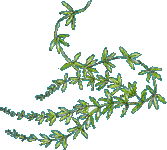
|
Hydrilla -
Boaters donít like hydrilla when it gets tangled in their propellers, but fishermen know this plant provides food and shelter for fish and the organisms that fish eat. (30 cm) |
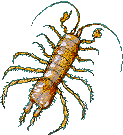
|
Isopod -
Isopods are crustaceans. Some are aquatic and some live on land. The land dwelling scud are commonly called pill bugs. Most aquatic species live under objects or in the mud in marshes or swamps. (0.5 - 1.5 cm) |

|
Mosquitofish -
Mosquitofish are related to guppies. They give birth to live babies instead of laying eggs like most other fish. Although they are tiny, these fish are important in the food chain because they gobble the larvae of mosquitoes that also live in the water - and because they are in turn eaten by larger fish. (2.5 - 5 cm) |

|
Mummichog -
Mummichogs swim in schools in shallow water along the shore. In fact, the word mummichog is a Native American word which means "going in crowds". They are more colorful than their relatives, the killifish, and have a rounded tail fin. (7 - 10 cm) |

| Pill Clam - Pill clams are common mollusks in the Potomac River. They have two hard, equal sized, round shells held together by a hinge. The shell protects the soft body parts of the clam inside. (< 2.5 cm) |

|
Scud -
Scud are tiny crustaceans related to shrimp. They are also called sideswimmers. They are flattened sideways, like fleas, and live close to the bottom of their habitat where they find bits of food in the mud. They are eaten by fish. (.5 - 1.5 cm) |

| Silverside Minnow - This fish gets its name from its shiny color. You can almost see right through its slender body. This is one of the most common minnows in the Potomac River. (7 - 10 cm) |

|
Snail -
Snails are mollusks with one coiled shell. Their eyes are located on the ends of the stalks on their heads. (< 2.5 cm) |
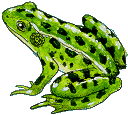
|
Southern Leopard Frog -
The Southern leopard frog is an amphibian with moist green skin -- and as its name implies, has many dark spots. Frogs can float just below the waterís surface with just their eyeballs and nostrils above the surface. (6.4 - 9cm) |

|
Tadpoles -
These immature amphibians live underwater and resemble fish. They develop into either toads, frogs, or salamanders. Tadpoles have soft, moist skin, breathe through gills and eat algae with their tiny mouths. Once they become adults, they will look much different with lungs, a wide "predator" mouth, and legs. (1 - 8 cm) |
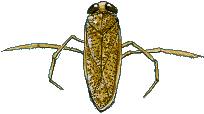
|
Water Boatman -
Water boatmen are insects that swim by using their long hind legs like oars. They have two sets of eyes - one set that sees above the waterís surface and one set that sees below the surface. They carry a bubble of air with them when they go underwater so they can breathe. (< 1.2 cm) |

|
Water Strider -
Water striders are insects that can walk or "skate" on the surface of the water. They watch for insects that fall onto the waterís surface, capture them and then, eat them. (.8 - 1.5 cm) |
|
| Whirligig Beetle - Whirligig beetles are insects about the size of a dime. They swim about rapidly in circles on the surface of the water, but if you try to catch one they may dive underwater to hide. They carry a bubble of air with them when they go underwater so they can breathe. |